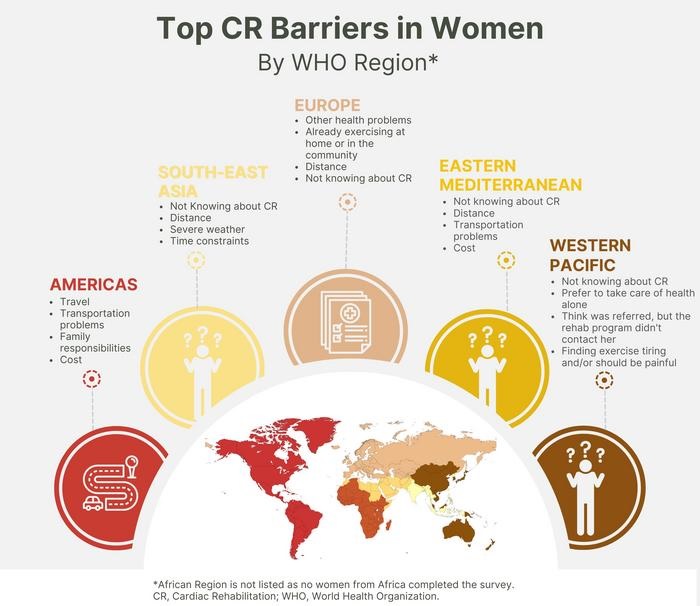A study published in the Canadian Journal of Cardiology evaluates the barriers to participation in cardiovascular rehabilitation programs for men and women and provides patients with strategies to mitigate them.
Background
Cardiac rehabilitation (CR) programs are underutilized globally, especially by women.
In this study, to our knowledge, for the first time we investigated sex differences in barriers to cardiac rehabilitation (CR) in all regions of the world, the characteristics associated with greater barriers in women, and the greatest barriers in women according to the registration status.
Methods
In this cross-sectional study, the English, Simplified Chinese, Arabic, Portuguese, or Korean versions of the Cardiac Rehabilitation Barriers Scale were administered to patients with an indication for cardiac rehabilitation (CR) worldwide via Qualtrics since October 2021. until March 2023. Members of the International Council of Cardiology Prevention and Rehabilitation community facilitated participant recruitment. Mitigation strategies were provided and rated.
Results
The participants were 2163 patients from 16 countries in the 6 regions of the World Health Organization; 916 (42.3%) were women.
Women did not report significantly higher total barriers overall, but did in 2 regions (America, Western Pacific) and men in 1 (Eastern Mediterranean; all P < 0.001).
Women’s barriers were greatest in the Western Pacific (2.6 ± 0.4/5) and Southeast Asian (2.5 ± 0.9) regions (P < 0.001), with lack of awareness about cardiac rehabilitation (CR) the biggest barrier in both.
Women who were unemployed reported significantly greater barriers than those who were not (P < 0.001).
Among non-enrolled referred women, the biggest barriers were not knowing about CR, not being contacted by the program, cost, and finding exercise exhausting or painful.
Among enrolled women, the greatest barriers to session completion were distance, transportation, and family responsibilities. The mitigation strategies were rated as very useful (4.2 ± 0.7/5).

Figure : Main barriers to cardiac rehabilitation (CR) in women according to World Health Organization region. The African region is not shown because there were no female respondents from Africa.
Conclusions Barriers to cardiac rehabilitation (CR) (men and women) vary significantly by region, requiring tailored mitigation approaches. Efforts should be made to mitigate barriers for unemployed women in particular. |
Comments
Cardiac rehabilitation ( CR) is a chronic disease management program in which patients receive support from a team of healthcare professionals over several months through management of medical risk factors, structured exercise, as well as education and counseling for the patient.
Cardiovascular rehabilitation (CR) improves health outcomes and well-being and can reduce death and rehospitalization rates by 20%. However, the programs are underutilized and women are much less likely to participate than men, so they do not reap these benefits.
This first global comparative study of barriers to the use of cardiac rehabilitation (CR) in men and women evaluates the extent of these barriers and explores ways in which patients can overcome them. It was determined that women and men face some common barriers, but also many different ones, and the barriers differ by global region. The study appears in the Canadian Journal of Cardiology , published by Elsevier.
Principal investigator Sherry L. Grace, PhD, CRFC, Faculty of Health, York University and KITE - Toronto Rehabilitation Institute, University Health Network, University of Toronto, explains: “The benefits of participation in cardiac rehabilitation are notable In addition, patients regain their vitality and can return to their significant roles in life. Unfortunately, women face many structural barriers to attendance, from the individual level to the health system level. We developed the Cardiac Rehabilitation Barriers Scale (CRBS) almost 25 years ago to better characterize them, and it remains the most widely used and rigorous measurement scale to assess these barriers.”
Although the Cardiac Rehabilitation Barriers Scale (CRBS) has been translated into more than 20 languages, prior to the present study it had never been administered to patients in more than one country at a time and had only been administered in a total of 25 countries. . Only two studies had been carried out in which the barriers of women and men were compared.
Professor Grace and co-principal investigator Gabriela Ghisi, PT, PhD, CRFC, also of KITE - Toronto Rehabilitation Institute, University Health Network at the University of Toronto, add: "It was time to examine the barriers to cardiac rehabilitation ( RC) on a global comparative basis to help "We understand the sex differences and the main barriers for women so we can address them and therefore get more women to enroll and fully participate in cardiac rehabilitation (CR)."
In this cross-sectional study, the CRBS was administered globally via an online survey to more than 2000 patients from 16 countries in all six regions of the World Health Organization. Community members from the International Council on Cardiovascular Prevention and Rehabilitation (ICCPR) helped recruit participants by identifying inpatient cardiac patients who were eligible for cardiac rehabilitation (CR) and patients who were just beginning CR. This is the first international study on barriers to CR utilization, including data from all regions of the world, and presents the first quantitative barrier data from Africa, as well as several European and Western Pacific countries. About 42% of the participants were women.
The study findings show that although female cardiac patients have a somewhat higher burden of barriers in the Western Pacific and the Americas than men, both men and women have significant barriers, which must be addressed to optimize CR utilization. Barriers for women were higher in the Western Pacific and Southeast Asia regions compared to other regions, with lack of awareness of cardiac rehabilitation (CR) being the largest barrier in both. Men in the Eastern Mediterranean region reported greater barriers than women. Unemployed women reported significantly greater barriers than those who were employed.
Among women who were not enrolled in CR programs, their biggest barriers were not knowing about CR, that the program did not contact them after referral, cost, and finding exercise exhausting or painful. Among women who were enrolled in a program, their greatest barriers to session adherence were distance, travel, family responsibilities, and difficulties accessing sessions that require in-person assistance (i.e., transportation).
Through the study, also for the first time, participants were provided with potential mitigation strategies to help overcome these barriers, such as speaking with a healthcare provider about how to access a program or doing a program at home. More than 70% of women and 40% of men rated the barrier-specific information provided as “helpful” or “very helpful . ” These observations should encourage the application of these types of mitigation strategies, as well as the development of further research on active mitigation strategies to improve adherence to cardiac rehabilitation (CR) programs.
Professor Grace already has further research underway to test whether strategies to mitigate the key barriers identified can result in increased RC participation. "We hope this will lead to more women enrolling in CR, and that would certainly have a positive impact on their health and well-being outcomes."
She urges: “Patients may have legitimate barriers to attending CR, but we recommend that they discuss them with healthcare providers as there are proven strategies to overcome them. Please help spread the word that cardiac rehabilitation (CR) is available in most countries around the world and saves lives! ”
A resource for patients to evaluate their own barriers along with mitigation suggestions is provided on the ICCPR website (Spanish version).
















